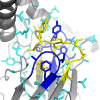RosettaAntibodyDesign (RAbD): A general framework for computational antibody design
- PMID: 29702641
- PMCID: PMC5942852
- DOI: 10.1371/journal.pcbi.1006112
RosettaAntibodyDesign (RAbD): A general framework for computational antibody design
Abstract
A structural-bioinformatics-based computational methodology and framework have been developed for the design of antibodies to targets of interest. RosettaAntibodyDesign (RAbD) samples the diverse sequence, structure, and binding space of an antibody to an antigen in highly customizable protocols for the design of antibodies in a broad range of applications. The program samples antibody sequences and structures by grafting structures from a widely accepted set of the canonical clusters of CDRs (North et al., J. Mol. Biol., 406:228-256, 2011). It then performs sequence design according to amino acid sequence profiles of each cluster, and samples CDR backbones using a flexible-backbone design protocol incorporating cluster-based CDR constraints. Starting from an existing experimental or computationally modeled antigen-antibody structure, RAbD can be used to redesign a single CDR or multiple CDRs with loops of different length, conformation, and sequence. We rigorously benchmarked RAbD on a set of 60 diverse antibody-antigen complexes, using two design strategies-optimizing total Rosetta energy and optimizing interface energy alone. We utilized two novel metrics for measuring success in computational protein design. The design risk ratio (DRR) is equal to the frequency of recovery of native CDR lengths and clusters divided by the frequency of sampling of those features during the Monte Carlo design procedure. Ratios greater than 1.0 indicate that the design process is picking out the native more frequently than expected from their sampled rate. We achieved DRRs for the non-H3 CDRs of between 2.4 and 4.0. The antigen risk ratio (ARR) is the ratio of frequencies of the native amino acid types, CDR lengths, and clusters in the output decoys for simulations performed in the presence and absence of the antigen. For CDRs, we achieved cluster ARRs as high as 2.5 for L1 and 1.5 for H2. For sequence design simulations without CDR grafting, the overall recovery for the native amino acid types for residues that contact the antigen in the native structures was 72% in simulations performed in the presence of the antigen and 48% in simulations performed without the antigen, for an ARR of 1.5. For the non-contacting residues, the ARR was 1.08. This shows that the sequence profiles are able to maintain the amino acid types of these conserved, buried sites, while recovery of the exposed, contacting residues requires the presence of the antigen-antibody interface. We tested RAbD experimentally on both a lambda and kappa antibody-antigen complex, successfully improving their affinities 10 to 50 fold by replacing individual CDRs of the native antibody with new CDR lengths and clusters.
Conflict of interest statement
The authors have declared that no competing interests exist.
Figures









References
-
- Diamandis EP, Christopoulos TK (1991). The biotin-(strept) avidin system: principles and applications in biotechnology. Clin Chem 37: 625–636. - PubMed
-
- Holliger P, Hudson PJ (2005). Engineered antibody fragments and the rise of single domains. Nat Biotechnol 23: 1126–1136. doi: 10.1038/nbt1142 - DOI - PubMed
-
- Hoogenboom HR (1997). Designing and optimizing library selection strategies for generating high-affinity antibodies. Trends Biotechnol 15: 62–70. doi: 10.1016/S0167-7799(97)84205-9 - DOI - PubMed
-
- Adams GP, Weiner LM (2005). Monoclonal antibody therapy of cancer. Nat Biotechnol 23: 1147–1157. doi: 10.1038/nbt1137 - DOI - PubMed
-
- Wu AM, Senter PD (2005). Arming antibodies: prospects and challenges for immunoconjugates. Nat Biotechnol 23: 1137–1146. doi: 10.1038/nbt1141 - DOI - PubMed
Publication types
MeSH terms
Substances
Grants and funding
LinkOut - more resources
Full Text Sources
Other Literature Sources

